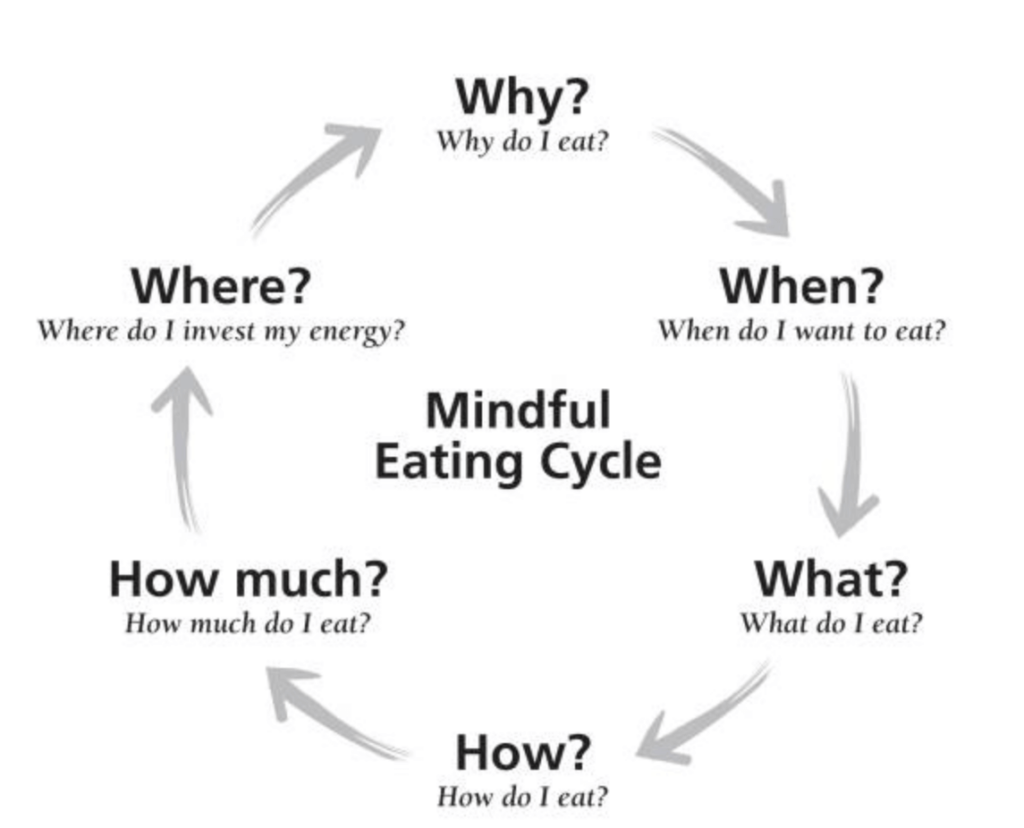An individual’s eating behaviour is often assumed to be in response to hunger, which represents the biological need for food in order to survive (i.e., depleted energy stores, biological need for food, food consumed until satiated). However, our social and cultural environment promotes eating in the absence of the physiological need for food. For example, individuals can eat in response to many internal or external cues that are not related to actual depleted energy stores, such as eating in response to food availability, the taste, your own negative or positive emotions, or social factors. All these examples can result in eating when one is not hungry or in need of food. When eating is separated from biological needs, one’s ability to self-regulate food intake in response to biological needs tends to diminish.

Highlights
- Mindful and intuitive eating practices can help regulate food behaviours and improve your relationship with food and your body,
- Mindful eating aims to apply mindfulness practices to internal sensations and increase present-focused awareness and non-judgemental observation of bodily sensations, cognitions and emotions,
- Intuitive eating is based on physiological hunger and satiety cues rather than external cues. It emphasizes that the mind, body, and food are in tune with one another, and focuses on strengthening the relationship among the three. These practices help athletes eat healthy and avoid restrictive or disordered eating patterns.
Mindful and intuitive eating
Mindful and intuitive eating can help regulate food behaviours and improve your relationship with food and your body. The two terms that are often used interchangeably but mean different things are: mindful eating and intuitive eating.
Mindful eating aims to apply mindfulness practices to internal sensations (i.e., physical hunger/satiety) and increase present-focused awareness and non-judgemental observation of bodily sensations, cognitions and emotions. It entails focusing on your eating experience without judgment. Mindful eating makes you aware of and understand your hunger (meaning its reasons, which could include emotions, scarcity, tradition, schedule, etc.).
Intuitive eating was developed by Elyse Resch and Evelyn Tribole in 1995 to encourage individuals to reject the ‘diet mentality’, which means relying on non-physiological factors (such as cognitive control) to ascertain food consumption instead of following the body’s natural self-regulation system. For example, the diet mindset would be asking, “does this food fit my calorie goal for the day?” while the intuitive eating mindset would say, “I can eat whatever food I desire.”
Intuitive eating is based on physiological hunger and satiety cues rather than external cues E ( such as emotions, availability, sight or smell of food, social settings that demand eating, serving sizes or even food packaging. Thus, intuitive eating involves training an individual to focus on responding to physical sensations in order to determine the body’s needs. It emphasizes the mind, body, and food to be in tune with one another, and focuses on strengthening the relationship among the three. Intuitive eating relies on trusting internal hunger and fullness as cues and giving oneself unconditional permission to eat when hungry. This promotes cognitive change, reduces emotional eating and increases body composition acceptance.
It is important to remember that mindful and intuitive eating are not types of diets. They are mindsets that require you to trust your natural instincts and listen to your body’s natural hunger and fullness cues.
Tylka and Kroon Van Diest developed the Intuitive Eating Scale (Tylka IES-2) wherein intuitive eating comprises the following central features:
- unconditional permission to eat whatever one desires and when hungry,
- eating for physical rather than emotional reasons,
- relying on internal hunger and satiety cues to decide when and how much to eat,
- honouring one’s health, or practising ‘gentle nutrition’.
Hawks et al, who developed an alternative Intuitive Eating Scale (Hawks IES), summarise the Intuitive Eating model as consisting of:
- intrinsic eating: the ability to recognize the physical signs of hunger, satisfaction and fullness
- extrinsic eating: considering a full range of food possibilities and eating what one wants
- anti dieting: appreciating food and paying attention to the physical effects of eating
- self-care: valuing health and energy over appearance

Eating habits of athletes
Athletes have unique nutritional needs, depending on their sport, energy expenditure, hydration and other factors. Similarly, they have their own unique challenges when it comes to nutrition.
Eating behaviours are personal, yet heavily influenced by the environment. Unhealthy behaviours and misinformation can undermine athletic performance and cause sports injuries or health risks. These could result in unhealthy dieting, restrictive or disordered eating (such as anorexia nervosa, bulimia nervosa, binge eating disorder, anorexia athletica and orthorexia nervosa), misuse of nutritional supplements, ‘uninformed’ vegetarianism and a variety of unhealthy weight-cutting practices that can sabotage athletic performance.
Conclusion
Athletes need to take special care of what they eat and their overall eating behaviours. While personal to each individual, eating habits are also influenced by external factors. This is where mindful and intuitive eating practices help, as they bring people in tune with the food they eat and their bodies’ natural need for food.
Disclaimer: The contents of this article are for general information and educational purposes only. It neither provides any medical advice nor intends to substitute professional medical opinion on the treatment, diagnosis, prevention or alleviation of any disease, disorder or disability. Always consult with your doctor or qualified healthcare professional about your health condition and/or concerns and before undertaking a new healthcare regimen including making any dietary or lifestyle changes.
References
- Anderson L. et al. (2015) Contributions of mindful eating, intuitive eating, and restraint to BMI, disordered eating, and meal consumption in college students. Eating and Weight Disorders. 21(1). https://www.researchgate.net/publication/280872314_Contributions_of_mindful_eating_intuitive_eating_and_restraint_to_BMI_disordered_eating_and_meal_consumption_in_college_students
- https://trace.tennessee.edu/cgi/viewcontent.cgi?article=6971&context=utk_gradthes
- Tylka T. & Kroon Van Diest A. (2013) The intuitive eating scale-2: item refinement and psychometric evaluation with college women and men. Journal of Counseling Psychology. 60(1):137-53. https://pubmed.ncbi.nlm.nih.gov/23356469/
- Bingham M. & Quatromoni P. (2015) Sports nutrition advice for adolescent athletes: a time to focus on food. American Journal of Lifestyle Medicine. 9(6). 398-402.








